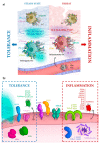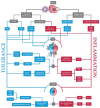Immune Tolerance in the Oral Mucosa
- PMID: 34830032
- PMCID: PMC8624028
- DOI: 10.3390/ijms222212149
Immune Tolerance in the Oral Mucosa
Abstract
The oral mucosa is a site of intense immune activity, where a large variety of immune cells meet to provide a first line of defense against pathogenic organisms. Interestingly, the oral mucosa is exposed to a plethora of antigens from food and commensal bacteria that must be tolerated. The mechanisms that enable this tolerance are not yet fully defined. Many works have focused on active immune mechanisms involving dendritic and regulatory T cells. However, epithelial cells also make a major contribution to tolerance by influencing both innate and adaptive immunity. Therefore, the tolerogenic mechanisms concurring in the oral mucosa are intertwined. Here, we review them systematically, paying special attention to the role of oral epithelial cells.
Keywords: T cell; dendritic cell; epithelial cell; mucosa; oral; tolerance.
Conflict of interest statement
The authors declare no conflict of interest.
Figures



References
-
- Gartner L.P. Oral anatomy and tissue types. Semin. Dermatol. 1994;13:68–73. - PubMed
-
- Nanci A. Ten Cate’s Oral Histology: Development, Structure, and Function. 8th ed. Elsevier; Montreal, QC, Canada: 2012.
Publication types
MeSH terms
Grants and funding
LinkOut - more resources
Full Text Sources

